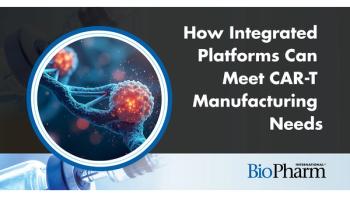
- BioPharm International, March 2024
- Volume 37
- Issue 3
- Pages: 20–26
Fouling Mechanisms of Filters During the Harvest Development of Monoclonal Antibody Therapeutics with Intensified Upstream Processes—Part 2
The authors evaluated the potential of direct filtration for multiple biopharmaceutical candidates. This article is Part 2 of the study.
Peer-Reviewed
Submitted: November 8, 2022.
Accepted: October 31, 2023.
Abstract
The harvest step in a monoclonal antibody downstream purification process removes biomass, particulates, and other material from the cell culture to generate a product stream suitable for purification by liquid chromatography. In a widely employed, two-step harvest process, coarse solids and intact cells are first removed using a centrifuge, and the resulting centrate is further clarified by depth and membrane filtration in series. Conversely, direct depth filtration has the potential to greatly simplify the overall harvest process by directly loading the cell culture broth on high-capacity depth filters and consequently removing the need for centrifugation. The authors evaluated this potential of direct filtration for multiple biopharmaceutical candidates to understand the underlying mechanisms that define fouling and the resulting capacity limitations in these filters. Here, the authors present a methodology to assess the contribution of individual filters to overall capacity of the direct filtration train, and elucidate how capacity is affected by characteristics of the cell culture broth and process parameters, including for enhanced upstream processes such as those incorporating high cell density perfusion. The findings highlight the limitations of direct filtration when implemented in large-scale facilities for high cell density processes. Ultimately, increased understanding of the fundamental principles that govern depth and membrane filtration can aid in moving from a trial-and-error to a more predictive and methodology-based approach for harvest development. This article is Part 2 of the study.
Introduction
In Part 1 of this study, previously published in the February 2024 issue of BioPharm International (1), the materials and methods, and study results for fouling Mechanisms of coarse depth filters were described. In this article—Part 2 of the study—the fouling mechanisms of fine depth filters, fouling mechanisms of sterile filters, relation between fouling and filter train capacity, and design strategy during harvest development will all be discussed.
About the authors
Stijn H. S. Koshari is a principal investigator, Hong Zhang is an investigator, Antonio Ubiera is a senior director, and Robert G. Luo*, robert.g.luo@gsk.com, is a scientific director, all at Downstream Process Development, BioPharma R&D, GlaxoSmithKline, King of Prussia, Pennsylvania 19406.
*To whom all correspondence should be addressed.
Article details
BioPharm International®
Vol. 37, No. 3
March 2024
Pages: 20–26
Citation
When referring to this article, please cite it as Koshari, S.H.S; Zhang, H.; Ubiera, A.; Luo, R.G. Fouling Mechanisms of Filters During the Harvest Development of Monoclonal Antibody Therapeutics with Intensified Upstream Processes—Part 2. BioPharm International, 2024, 37 (3) 20–26.
Articles in this issue
almost 2 years ago
Moving Biosimilars Forward in a Hesitant Marketalmost 2 years ago
Proprietary Cell-Line Development for High-Titer AAV Manufacturingalmost 2 years ago
The Making of mRNAalmost 2 years ago
Automating the Future of Fill/Finishalmost 2 years ago
Biologics Quality Control: The Growing Need for Accessible Proteomicsalmost 2 years ago
First in Line on Catalent’s Linealmost 2 years ago
Ensuring Contractors Perform Good Distribution PracticesNewsletter
Stay at the forefront of biopharmaceutical innovation—subscribe to BioPharm International for expert insights on drug development, manufacturing, compliance, and more.




